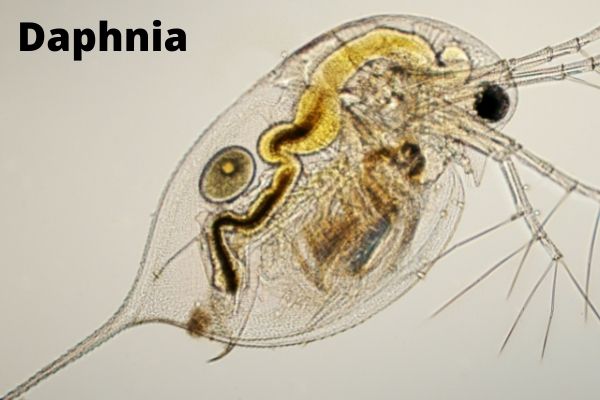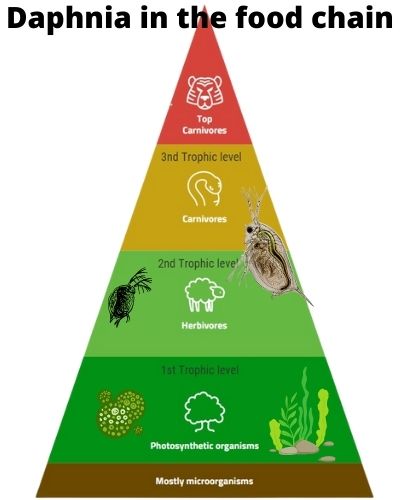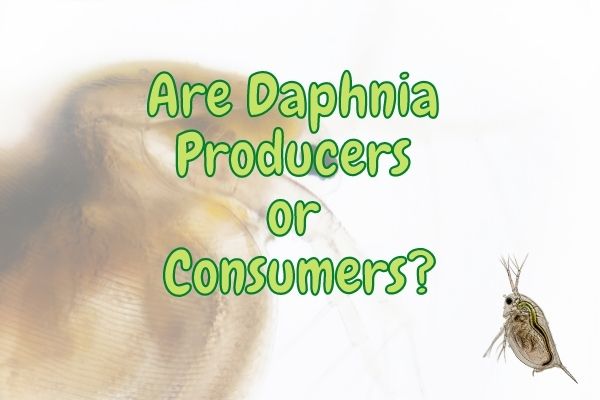Daphnia are planktonic creatures that are classified as crustaceans like crabs, lobsters, and crayfish! They are small in size around 0.2 mm-6.0 mm and are aquatic planktonic crustaceans which are commonly called water fleas.
They come under the category of consumers that are typically found in freshwater environments. As secondary consumers, they play an important role in the food web by filtering out producers like algae and smaller consumers like zooplankton.
For instance, Daphnia is commonly used to clear fish tanks of algae blooms as they feed heavily on fine detritus, bacteria, and small algal particles.
Daphnia are filter-feeding consumers, which means that they strain their food (algae, bacteria, etc.) from the water using specialized mouthparts. They are able to consume a variety of small animal and plant items, including dead organic matter, but prefer to eat live prey so they are not considered decomposers.
Daphnia is a genus of about 200 species, all within the family Daphniidae. And Family Daphniidae comes under the order Anomopoda. They are broadly classified under the Kingdom Animalia.
In the wild, Daphnia primarily eat algae and suspended particles in the water. However, they will also consume smaller animals like bacterial flora, zooplankton, rotifers, and even other Daphnia. So, they are consumers of the ocean.
A Daphnia is extremely tiny and its body is shaped like a small pill, with its mouth at the top. It contains two simple eyespots.
Their diet changes based on what is available in their environment, and what stage of life they are in (e.g. juveniles vs. adults).
The mouth is surrounded by a pharynx, which functions as both a food channel and a water channel. Inside the pharynx is a sac called the bursa, which functions as the gut.

The bursa is lined with cilia that function to keep food moving through. The organism is flattened, allowing it to move by spinning its body.
Daphnia is a genus of freshwater organisms that are small, zooplanktonic (floating in the water), and filter feeders.
As such, they are eaten by other aquatic animals, including fish, salamanders, and other Daphnia. Daphnia are also eaten by other organisms that filter feed on detritus, including crayfish and fish, and may be consumed by humans directly.
Contents
What role do Daphnia play in the ecosystem?
Daphnia are an important part of the ecosystem because they are filter feeders. This means that they help to clean the water by eating algae and other small organisms. They are also a food source for many other animals, such as fish, amphibians, and reptiles.
Daphnia play an important role in the food web because they are both primary and secondary consumers. This means that they eat both plants and other animals are omnivores.
As primary consumers, they eat algae and other tiny organisms that make up the base of the food web in an aquatic system. As secondary consumers, they eat other small particles and animals. By eating both plants and animals, Daphnia helps to transfer energy from one level of the food web to another.
Daphnia are also an important part of the nitrogen cycle. Nitrogen is a nutrient that is needed by all living things for growth. Daphnia helps to recycle nitrogen by eating dead plants and animals and then releasing it back into the water in their waste products.
Are Daphnia Producers, Consumers or Decomposers?
Daphnia are consumers because they eat other living organisms. Daphnia being omnivores feed on both plant and animal matter in water. They depend on other organisms for energy in the form of food and hence are consumers.
They are incapable of producing their own food and cannot be called producers. Only certain bacteria, algae, protozoa and all plants are producers.
What Type of Consumer is a Daphnia?
Daphnia are secondary consumers in a food chain because they eat other consumers as well as producers.
Are Daphnia Omnivores, Herbivores or Carnivores?
Daphnia are omnivores because they are known to eat both plants and animals species in water. This actually makes them secondary consumers, however, because they are mostly primary consumers in their native ecosystem.
Herbivores are primary consumers, omnivores are secondary consumers and carnivores are tertiary consumers in a typical food chain.
Are Daphnia Decomposers?
Daphnia are consumers because they eat aquatic producers like algae, but they are secondary consumers and not decomposers because they eat other living aquatic creatures.
Although they are eaten by other organisms, they do not break down dead matter into usable nutrients. Bacteria and fungi do that and are therefore decomposers.
Where is Daphnia in a Food Chain?
Daphnia can be a primary consumer when feeding on a producer and when they feed on other small animals they function as secondary consumers.

Herbivores are primary consumers, omnivores are secondary consumers and carnivores are tertiary consumers.
Are Daphnia Autotrophs or Heterotrophs?
Daphnia are heterotrophs because they depend on other organisms for nutrition. Practically no animals are autotrophic because animals do not get their energy directly from the sun and cannot prepare their own food like plants do.
They may look green, but they are not plants and therefore not producers! Their color comes from the algae that they eat seen through their transparent body.
That is, aquatic animals like the Daphnia cannot make their own food, but need to eat other organisms for energy and a carbon source.
What Animals Prey on Daphnia?
Daphnia are food for a variety of animals including tadpoles, flies, copepods, water fleas, water lice, midge larvae, water mites and fish.
Many decomposers and scavengers also eat Daphnia when it dies.
When the Daphnia is dead, it is likely that smaller detritivores of the ocean like worms, crabs, slugs and some fish will smell it and begin to feed on it. A dead Daphnia will be eaten by scavengers and bacteria in a matter of months.
Conclusion
In this blog post, we have looked at the role of the Daphnia in the food chain and how it thrives in a n aquatic setting. We have looked at the habitat of Daphnia and their role as secondary consumers in the aquatic food chain.
Daphnia are important because they are the first to feed on the bacteria and algae in the water. They are also filter feeders, filtering out the food for their own consumption and keeping the aquatic environment clean and stable.
Daphnia are a very important group of organisms in the food chain, and they are found in many different habitats! They are also a very important part of the food chain in aquatic systems, and are often the first to feed on the bacteria and algae in the water!
You can read more about other sea creatures and their role in the food chain in my previous posts!





